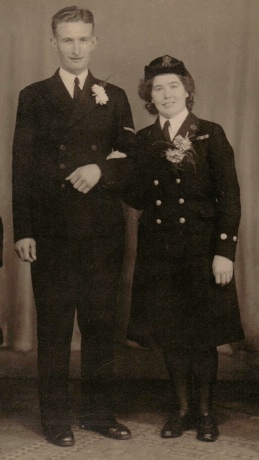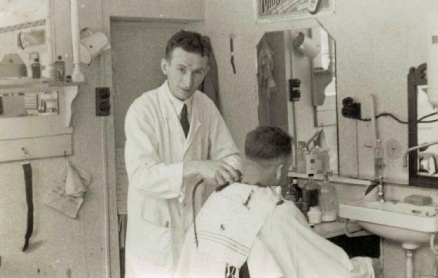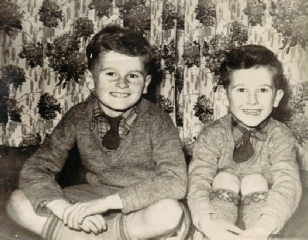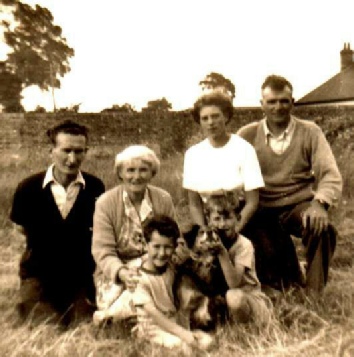 One question we are often asked is “How did we end-up living at the Great Wakering British Legion Clubhouse during our childhood years?” Well, the Wakering Branch of the Royal British Legion (founded in 1922) decided they needed a clubhouse and in 1951 they had the opportunity to purchase the local vicarage at number 204, High Street for £2,500. However, according to a quote from the late Life Vice-President Bill Stow “Many of the committee members had little idea of running such a property and ex-Navy stewards, Reg and Nancy Lee, stepped in and were an absolute godsend in organisational terms, especially in running a bar.”
One question we are often asked is “How did we end-up living at the Great Wakering British Legion Clubhouse during our childhood years?” Well, the Wakering Branch of the Royal British Legion (founded in 1922) decided they needed a clubhouse and in 1951 they had the opportunity to purchase the local vicarage at number 204, High Street for £2,500. However, according to a quote from the late Life Vice-President Bill Stow “Many of the committee members had little idea of running such a property and ex-Navy stewards, Reg and Nancy Lee, stepped in and were an absolute godsend in organisational terms, especially in running a bar.”
Mum (Nancy) joined the junior ranks of the Women’s Royal Navy Service at the beginning of World War 2 and ended up as a Chief Petty Officer. At the age of 28 years, she was honoured to be awarded the British Empire Medal (BEM) for ‘meritorious service’, which was presented to her by King George VI.
Dad (Reg) played a supporting role to mum who was involved in the lion’s share of activities at the clubhouse. His main employment was running his barbershop located in Smith Street, Shoeburyness and sometimes he would cut members and their children’s hair at the clubhouse.
The photograph [left] was taken on the day of mum and dad’s wedding.
 The photograph [right] was taken of our dad in his barbershop in Smith Street, Shoeburyness.
The photograph [right] was taken of our dad in his barbershop in Smith Street, Shoeburyness.
We remember moving to the old vicarage building in 1951, whilst it was being converted into a clubhouse. Major ground and structural work had to be carried out over a six-month period before the clubhouse could be opened to members. Work included the outhouse buildings which had to be converted into gents and ladies toilets for the members. Ground floor rooms had to be converted into two bar lounge areas, one at the front and one at the rear of the building. Between them was a small bar serving area. Initially drinks from the bar could only be served to each lounge via small serving hatches which were 2 feet square, approximately. The front of the building’s 1st floor was converted into the ‘assembly room’ and one of the back rooms was made into a ‘snooker room’.
We (Dave and Vic) were 4 and 3 years old respectively at the time and too young to start school.
 It must have been a nightmare for mum, keeping us out of harm’s way with outside open trenches for sewage pipe work and throughout the building floorboards were up for plumbing and electrical installation work. Prior to moving to the clubhouse we had lived in a bungalow and falling down stairs from our attic bedroom on the 2nd floor was a new experience for us. Fortunately no injuries occurred during these experiences.
It must have been a nightmare for mum, keeping us out of harm’s way with outside open trenches for sewage pipe work and throughout the building floorboards were up for plumbing and electrical installation work. Prior to moving to the clubhouse we had lived in a bungalow and falling down stairs from our attic bedroom on the 2nd floor was a new experience for us. Fortunately no injuries occurred during these experiences.
When the clubhouse initially opened to members, the two lounge bar floors were well worn wooden floor boards and the only heating in the winter was provided by paraffin heaters. Eventually, heavy duty brown coloured lino was purchased for the lounge floors, main entrance hall and assembly room. Also gas fires were installed in both lounges which made them feel cosier in the cold winter months. Talking about feeling cold, our attic bedroom often felt like sleeping in a freezer in the winter months. A few years later our hot water bottles became redundant with the advent of the electric blanket, but like so many households in those days we would wake-up to ice on the inside of our single glazed bedroom window.
The photograph [above] was taken of us sitting on the floor in the rear bar lounge.
The clubhouse became a popular venue for holding village wedding receptions and parties in the assembly room and we would help (on reflection, more likely hinder) setting-up the wooden trestle tables and chairs. It was on one of those occasions when a party of guests started dancing to ‘knees-up mother brown’ that the floor of the room started to collapse into the downstairs main entrance hall. Hence, the dancing stopped and the following morning the main entrance hall ceiling had to be supported by pit-props until an RSJ support beam could be fitted.
 Most of the club’s members had served in World War 2 and a few in World War 1 and they had many a tale to tell us of their exploits. Lieutenant Colonel Kent, who lived in the High Street at Lee Lotts House, after retiring from the army ran a small holding with the help of Bill, one of his sons. Lee Lotts House was eventually sold to enable the development of the current Lee Lotts housing estate. Lieutenant Colonel Kent could always tell a good tale, one of them being when he was serving in World War 1. He was sent to the front line to sort out a situation where a group of soldiers were refusing to take orders from their sergeant, who was threatening to shoot them on the spot. When he arrived on the scene it was total chaos. Gun crews and their horse drawn gun carriages were bogged down in thick mud and their sergeant was insisting they kept the gun carriages, horses and their tack clean and polished to parade ground inspection standards. The colonel immediately relieved the sergeant from his duties who was possibly suffering from ‘shell shock’ and the gun carriage crews moved on through the thick muddy landscape to take-up their positions on the battlefield.
Most of the club’s members had served in World War 2 and a few in World War 1 and they had many a tale to tell us of their exploits. Lieutenant Colonel Kent, who lived in the High Street at Lee Lotts House, after retiring from the army ran a small holding with the help of Bill, one of his sons. Lee Lotts House was eventually sold to enable the development of the current Lee Lotts housing estate. Lieutenant Colonel Kent could always tell a good tale, one of them being when he was serving in World War 1. He was sent to the front line to sort out a situation where a group of soldiers were refusing to take orders from their sergeant, who was threatening to shoot them on the spot. When he arrived on the scene it was total chaos. Gun crews and their horse drawn gun carriages were bogged down in thick mud and their sergeant was insisting they kept the gun carriages, horses and their tack clean and polished to parade ground inspection standards. The colonel immediately relieved the sergeant from his duties who was possibly suffering from ‘shell shock’ and the gun carriage crews moved on through the thick muddy landscape to take-up their positions on the battlefield.
As children living at the clubhouse, it gave us and our friends, great opportunities for adventure, such as making camps in the loft spaces of the outbuildings and the large garden with a mature mulberry tree, which we would climb. Now the garden is totally covered in tarmac to provide member’s car parking. In 1951 only 1 or 2 members owned a motor car.
The photograph [right] shows us children in the garden with some of our relatives and ‘Jock’ our pet dog.
This gave us plenty of opportunities to run wild, camp out over night during the school summer holidays. Not to mention in our early teen years the use of the snooker table, table tennis and darts facilities.


 One question we are often asked is “How did we end-
One question we are often asked is “How did we end- The photograph [right] was taken of our dad in his barbershop in Smith Street, Shoeburyness.
The photograph [right] was taken of our dad in his barbershop in Smith Street, Shoeburyness. It must have been a nightmare for mum, keeping us out of harm’s way with outside open trenches for sewage pipe work and throughout the building floorboards were up for plumbing and electrical installation work. Prior to moving to the clubhouse we had lived in a bungalow and falling down stairs from our attic bedroom on the 2nd floor was a new experience for us. Fortunately no injuries occurred during these experiences.
It must have been a nightmare for mum, keeping us out of harm’s way with outside open trenches for sewage pipe work and throughout the building floorboards were up for plumbing and electrical installation work. Prior to moving to the clubhouse we had lived in a bungalow and falling down stairs from our attic bedroom on the 2nd floor was a new experience for us. Fortunately no injuries occurred during these experiences.  Most of the club’s members had served in World War 2 and a few in World War 1 and they had many a tale to tell us of their exploits. Lieutenant Colonel Kent, who lived in the High Street at Lee Lotts House, after retiring from the army ran a small holding with the help of Bill, one of his sons. Lee Lotts House was eventually sold to enable the development of the current Lee Lotts housing estate. Lieutenant Colonel Kent could always tell a good tale, one of them being when he was serving in World War 1. He was sent to the front line to sort out a situation where a group of soldiers were refusing to take orders from their sergeant, who was threatening to shoot them on the spot. When he arrived on the scene it was total chaos. Gun crews and their horse drawn gun carriages were bogged down in thick mud and their sergeant was insisting they kept the gun carriages, horses and their tack clean and polished to parade ground inspection standards. The colonel immediately relieved the sergeant from his duties who was possibly suffering from ‘shell shock’ and the gun carriage crews moved on through the thick muddy landscape to take-
Most of the club’s members had served in World War 2 and a few in World War 1 and they had many a tale to tell us of their exploits. Lieutenant Colonel Kent, who lived in the High Street at Lee Lotts House, after retiring from the army ran a small holding with the help of Bill, one of his sons. Lee Lotts House was eventually sold to enable the development of the current Lee Lotts housing estate. Lieutenant Colonel Kent could always tell a good tale, one of them being when he was serving in World War 1. He was sent to the front line to sort out a situation where a group of soldiers were refusing to take orders from their sergeant, who was threatening to shoot them on the spot. When he arrived on the scene it was total chaos. Gun crews and their horse drawn gun carriages were bogged down in thick mud and their sergeant was insisting they kept the gun carriages, horses and their tack clean and polished to parade ground inspection standards. The colonel immediately relieved the sergeant from his duties who was possibly suffering from ‘shell shock’ and the gun carriage crews moved on through the thick muddy landscape to take-